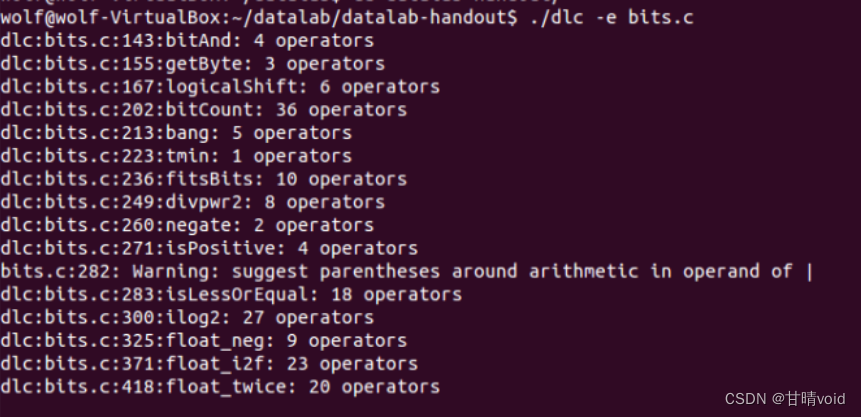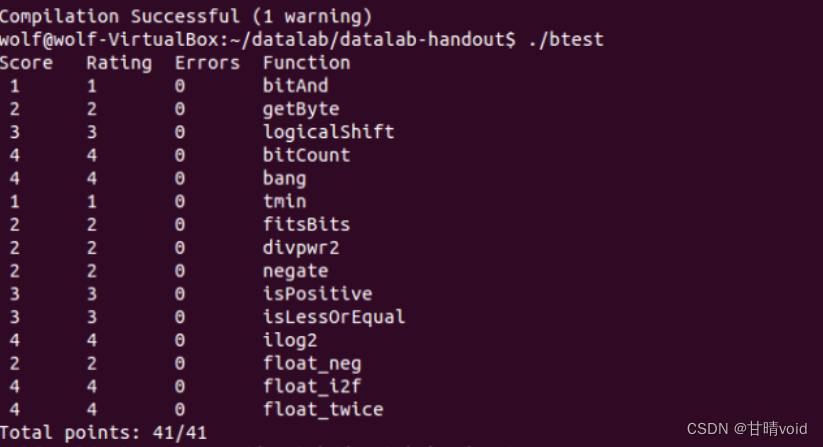写在前面
首先要感谢A橙_大佬,在之前的实验以及学习中,许多地方参考与学习了大佬的思路。
包括惊喜地发现,本次实验的验收助教居然就是A橙_大佬。……

虽然最后没用勇气去找大佬验收,换了另外一位助教验收嘿嘿……
以及,这个datalab,真的很考验对于位运算以及浮点数存储的理解,如果真的肯花时间去搞懂,对计算机系统存储的理解真的能上一个台阶。
一.实验题目及要求
在给定规则限制下完成bits.c中的函数。其中最主要的规则如下:
整数规则
1、不能使用for while if等
2、只能使用! ˜ & ˆ | + << >>运算符
3、只能使用int
4、只能使用0-0xFF的常数
5、使用运算符数不超过限制(Max ops)
6、不能使用全局变量或调用函数等其他规则
浮点数
1、可以使用for while if
2、只能使用int,unsigned int
3、使用运算符数不超过限制(Max ops)
4、不能使用数组,函数调用等其他规则
完成bits.c后使用./dlc检查代码是否符合规范,make btest进行编译,./btest进行函数测试。
二、实验过程
1、bitAnd
实验要求:使用按位或和按位取反实现按位与
/*
* bitAnd - x&y using only ~ and |
* Example: bitAnd(6, 5) = 4
* Legal ops: ~ |
* Max ops: 8
* Rating: 1
*/思路:使用德摩根定律将“按位与”操作转换为“按位取反”和“按位或”操作。
解答:
int bitAnd(int x, int y)
{
return ~(~x | ~y);
}2、getByte
实验要求:从x中取第n个有效位的4位数字
/*
* getByte - Extract byte n from word x
* Bytes numbered from 0 (LSB) to 3 (MSB)
* Examples: getByte(0x12345678,1) = 0x56
* Legal ops: ! ~ & ^ | + << >>
* Max ops: 6
* Rating: 2
*/思路:先将x右移8*n个位置,再与0x000000ff相与消去前24位。
解答:
int getByte(int x, int n)
{
return ((x >> (n << 3)) & 0xff);
}3、logicalShift
实验要求:将x逻辑右移n位
/*
* logicalShift - shift x to the right by n, using a logical shift
* Can assume that 0 <= n <= 31
* Examples: logicalShift(0x87654321,4) = 0x08765432
* Legal ops: ! ~ & ^ | + << >>
* Max ops: 20
* Rating: 3
*/思路:由于直接对x右移的结果是算术右移,即会将可能的符号位向右补齐。所以我们要构造一个左边n位都是0的数与我们的结果相与,就可以消掉这个影响。
解答:
int logicalShift(int x, int n)
{
return ((x >> n) & (~(((1 << 31) >> n) << 1)));
}4、bitCount
实验要求:统计出x的二进制表示中有多少个1
/*
* bitCount - returns count of number of 1's in word
* Examples: bitCount(5) = 2, bitCount(7) = 3
* Legal ops: ! ~ & ^ | + << >>
* Max ops: 40
* Rating: 4
*/思路:先构造出0x55555555、0x33333333、0x0f0f0f0f、0x00ff00ff、0x0000ffff,
之后采用分治的算法,分别统计每2个、每4个、每8个、每16个、与最后的整体32个所含1的个数。
解答:
int bitCount(int x)
{
int t1, t2, t3, t4, t5;
t1 = 0x55;
t1 = t1 + (t1 << 8);
t1 = t1 + (t1 << 16);
// t1=0x55555555
t2 = 0x33;
t2 = t2 + (t2 << 8);
t2 = t2 + (t2 << 16);
// t2=0x33333333
t3 = 0x0f;
t3 = t3 + (t3 << 8);
t3 = t3 + (t3 << 16);
// t3=0x0f0f0f0f
t4 = 0xff;
t4 = t4 + (t4 << 16);
// t4=0x00ff00ff
t5 = 0xff;
t5 = t5 + (t5 << 8);
// t5=0x0000ffff
x = (x & t1) + ((x >> 1) & t1);
x = (x & t2) + ((x >> 2) & t2);
x = (x & t3) + ((x >> 4) & t3);
x = (x & t4) + ((x >> 8) & t4);
x = (x & t5) + ((x >> 16) & t5);
return x;
}5、bang
实验要求:不用!达到逻辑反的结果
/*
* bang - Compute !x without using !
* Examples: bang(3) = 0, bang(0) = 1
* Legal ops: ~ & ^ | + << >>
* Max ops: 12
* Rating: 4
*/思路:本题是经过了学习之后才理解的。这道题的本质就是判断x是否为0,若为0,就输出1,否则就输出0。从补码上来看,一个数的补码必然与本身不同,补码等于本身的数只有0x00000000和0x80000000,即0和补码最小数。但是我们发现,只有0与其补码按位或之后为0,结果输出1。包括补码最小数在内的其他数与其补码按位或结果为1,此时右移31位出现-1,结果输出0。
解答:
int bang(int x)
{
return ((x | (~x + 0x1)) >> 31) + 1;
}6、tmin
实验要求:返回补码最小值
/*
* tmin - return minimum two's complement integer
* Legal ops: ! ~ & ^ | + << >>
* Max ops: 4
* Rating: 1
*/思路:输出最小的补码0x80000000,即符号位为1,后面全是0
解答:
int tmin(void)
{
return (0x1 << 31);
}7、fitsBits
实验要求:判断x是否能被n位补码表示
/*
* fitsBits - return 1 if x can be represented as an
* n-bit, two's complement integer.
* 1 <= n <= 32
* Examples: fitsBits(5,3) = 0, fitsBits(-4,3) = 1
* Legal ops: ! ~ & ^ | + << >>
* Max ops: 15
* Rating: 2
*/思路:若x可以被n位补码表示,则x的第(n+1)位到第32位应该都是无效位,则将x先左移(32-n)位再右移(32-n)位,若与原来的x相同(使用异或来判断),则它的确可以被表示。
解答:
int fitsBits(int x, int n)
{
return !(((x << (32 + (~n) +1)) >> (32 + (~n) +1)) ^ x);
}8、divpwr2
实验要求:计算x整除2^n后的结果
/*
* divpwr2 - Compute x/(2^n), for 0 <= n <= 30
* Round toward zero
* Examples: divpwr2(15,1) = 7, divpwr2(-33,4) = -2
* Legal ops: ! ~ & ^ | + << >>
* Max ops: 15
* Rating: 2
*/思路:右移n位,对负数进行偏移处理。
解答:
int divpwr2(int x, int n)
{
int bias = ((1 << n) + (~1 + 1)) & (x >> 31);
return ((x + bias) >> n);
}9、negate
实验要求:返回x的相反数
/*
* negate - return -x
* Example: negate(1) = -1.
* Legal ops: ! ~ & ^ | + << >>
* Max ops: 5
* Rating: 2
*/思路:对于补码来说,取反加一即可。
解答:
int negate(int x)
{
return ((~x) + 0x1);
}10、isPositive
实验要求:
/*
* isPositive - return 1 if x > 0, return 0 otherwise
* Example: isPositive(-1) = 0.
* Legal ops: ! ~ & ^ | + << >>
* Max ops: 8
* Rating: 3
*/思路:一个正数x等价于x符号位为0并且x不为0x00000000,这里由于不能使用条件符,需要使用德摩律做一个小小的转换。
解答:
int isPositive(int x)
{
return !((x>>31)|(!x));
}11、isLessOrEqual
实验要求:比较x是否小于等于y
/*
* isLessOrEqual - if x <= y then return 1, else return 0
* Example: isLessOrEqual(4,5) = 1.
* Legal ops: ! ~ & ^ | + << >>
* Max ops: 24
* Rating: 3
*/思路:分情况讨论;若x与y同号,则x-y的符号位为1或者x-y=0;若x与异号,则x小于0,使用按位或来连接这两个情况即可。
解答:
int isLessOrEqual(int x, int y)
{
int sign = !((x >> 31) ^ (y >> 31));
return (sign & (((x + (~y) + 0x1) >> 31) | !(x + (~y) + 0x1)) | (!sign & (x >> 31)));
}12、ilog2
实验要求:求floor(log2(x))
/*
* ilog2 - return floor(log base 2 of x), where x > 0
* Example: ilog2(16) = 4
* Legal ops: ! ~ & ^ | + << >>
* Max ops: 90
* Rating: 4
*/思路:题目本质是求x的二进制码最高位在哪里。采用分治的思想,分区域寻找,用y来保存当前寻找的地址。每进一步寻找就重新保存更新后的地址,这样逐步缩小范围直至最终找到答案。
解答:
int ilog2(int x)
{
int y = 0;
y = (!!(x >> 16)) << 4;
y = y + ((!!(x >> (y + 8))) << 3);
y = y + ((!!(x >> (y + 4))) << 2);
y = y + ((!!(x >> (y + 2))) << 1);
y = y + (!!(x >> (y + 1)));
return y;
}13、float_neg
实验要求:
返回浮点参数f的表达式-f的位等效项。参数和结果都作为无符号int传递,但是它们将被解释为单精度浮点值的位级表示。当参数为NaN时,返回参数。
/*
* float_neg - Return bit-level equivalent of expression -f for
* floating point argument f.
* Both the argument and result are passed as unsigned int's, but
* they are to be interpreted as the bit-level representations of
* single-precision floating point values.
* When argument is NaN, return argument.
* Legal ops: Any integer/unsigned operations incl. ||, &&. also if, while
* Max ops: 10
* Rating: 2
*/思路:
函数的参数可能为NaN,所以需要进行判断。如果参数uf的第23位到第30位全为1,而且uf的低23位不为0,这说明uf解释为单精度浮点值的位级表示时是一个NaN,所以应该直接返回,否则应直接将uf的最高位(符号位)取反即可得到-f。
解答:
unsigned float_neg(unsigned uf)
{
unsigned w, x, y, z, t;
w = (1 << 23) - 1; //尾数全1模板
x = 0xff << 23; //阶码全1模板
y = uf & w;
z = uf & x;
if ((z == x) && y)
{
return uf;
}
t = (1 << 31) ^ uf;
return t;
}14、float_i2f
实验要求:返回表达式(浮点数)x的等价位。 结果以unsigned int形式返回,但是将其解释为单精度浮点值的位级表示。
/*
* float_i2f - Return bit-level equivalent of expression (float) x
* Result is returned as unsigned int, but
* it is to be interpreted as the bit-level representation of a
* single-precision floating point values.
* Legal ops: Any integer/unsigned operations incl. ||, &&. also if, while
* Max ops: 30
* Rating: 4
*/思路:若x为0,则直接返回,否则按照int分别求阶码、尾数并赋给float的相应位置。这里使用while将absx不断向左移位,当absx的最高位1所在位置到达最左边的时候,表示位移已经到了尽头,此时记录下向左移位的次数,用31减去它,可以得到未修正的阶码e,e再考虑偏置量127就可以得到阶码E。这个过程就相当于将absx向右移位直到形成1.M这样的结构,同时刚刚absx移位的结果也就是尾数M的值。这里的tail是absx移位之后的末八位,如果tail比0x10000000大,表示这里是“舍入”的“入”,最后还需进1;如果tail恰好等于0x10000000,此时考虑的是“舍入”的特殊情况,向偶舍入。此时考虑前面尾数M的末位是否为1,若为1,则要进位,向偶数舍入。
解答:
unsigned float_i2f(int x)
{
unsigned sign = 0, enow = 0, fnow = 0, absx = x,
shiftLeft = 0, tail = 0, result = 0;
unsigned pos = 1 << 31;
if (x == 0)
{
return 0;
}
else if (x < 0)
{
absx = -x;
sign = pos;
}
while ((pos & absx) == 0)
{
absx <<= 1;
shiftLeft += 1;
}
enow = 127 + 31 - shiftLeft;
tail = absx & 0xff;
fnow = (~(pos >> 8)) & (absx >> 8);
result = sign | (enow << 23) | fnow;
if (tail > 0x80)
{
result += 1;
}
else if (0x80 == tail)
{
if (fnow & 1)
{
result += 1;
}
}
return result;
}15、float_twice
实验要求:返回浮点参数f的表达式2 * f的位等效项。参数和结果都作为unsigned int传递,但是它们将被解释为的位级表示。当参数为NaN时,返回参数。
/*
* float_twice - Return bit-level equivalent of expression 2*f for
* floating point argument f.
* Both the argument and result are passed as unsigned int's, but
* they are to be interpreted as the bit-level representation of
* single-precision floating point values.
* When argument is NaN, return argument
* Legal ops: Any integer/unsigned operations incl. ||, &&. also if, while
* Max ops: 30
* Rating: 4
*/思路:按照如下方式,分别分离原float的阶码、尾数并计算得到答案float的阶码,尾数最后返回即可。具体步骤如下。先判定,若为0x00000000或者0x80000000(就是0),则没有对它乘的必要,直接返回即可。否则分离出它的符号S、阶码E和尾数M。若阶码为0xff(即11111111),那么这是一个表示NaN或者inf的数,不必处理,直接返回即可。否则考虑若其阶码为0x0(即00000000),那么这是一个就绝对值较小数,我们先对它的尾数M左移,如果有进位,就表示阶码需要变了,阶码进一;若没有进位,则不需要特殊处理。若其阶码不是特殊值,那么只需要对阶码进行+1操作就可以使它倍增了。最后将这些S、E、M部分拼接即可得到最终的答案。
解答:
unsigned float_twice(unsigned uf)
{
unsigned sign = 0, enow = 0, fnow = 0;
unsigned pos = 1 << 31;
unsigned frule = (1 << 23) - 1; //尾数全为1
if (uf == 0)
{
return 0;
}
if (uf == pos)
{
return uf;
}
sign = uf & pos;
enow = (uf >> 23) & 0xff;
if (enow == 0xff)
{
return uf;
}
fnow = uf & frule;
if (enow == 0)
{
fnow = fnow << 1;
if (fnow & (1 << 23))
{
fnow = fnow & frule;
enow += 1;
}
}
else
{
enow += 1;
}
return sign | (enow << 23) | fnow;
}16、验证
(1)使用./dlc -e bits.c检验操作合规性以及操作数合法性

(2)使用./btest检验代码对数据正确性
 (3)上述两步也可以被简化为使用./driver.pl进行验证。
(3)上述两步也可以被简化为使用./driver.pl进行验证。

(4)可以验证代码正确。
三、实验总结
DataLab是一个用来检验我们对于计算机系统机器表示以及位运算的理解的一个非常好的实验。通过实验,我熟悉了位的基本操作,更进一步熟悉了数的机器表达形式以及特点。熟悉了异或取反判等,移位和0x1与得符号位等基本的位操作,通过使用一些数的特性,算数右移左移操作特点进一步熟练了整数和浮点数在位级的表示与一些运算方法。
此外还有与老师和同学的讨论等,这些都能为最终的结果带来很大的帮助。当然最重要的还是知识本身的理解,通过不断地试错我一步一步地改进方法,最终向着正确迈进。
另外的是一些解题的技巧与经验的总结。
(1)清除(保留)特定的位:使用特殊的数进行与运算(0xFF,0x1FF..)
(2)分治:将问题分解为16位,8位,4位..逐步处理(或自底向上处理)
(3)取反+1得到相反数
(4)0x0和0x80000000的相反数是本身
(5)作差判断大小,考虑符号不同的溢出情况
(6)浮点数乘2:规格化阶码+1,非规格化左移1位